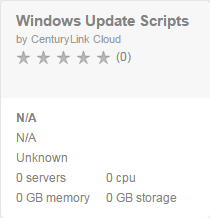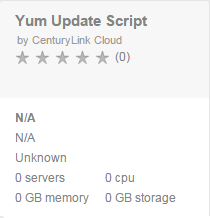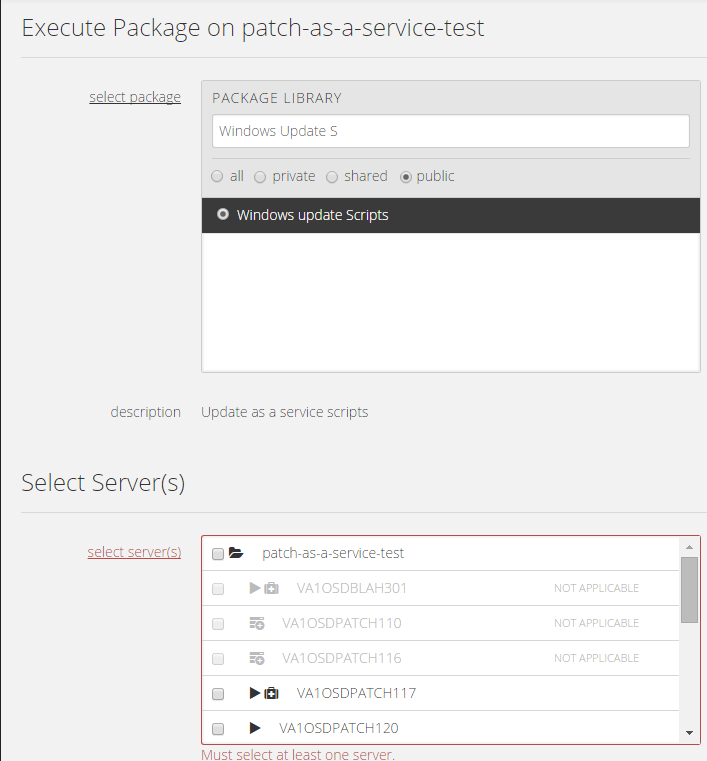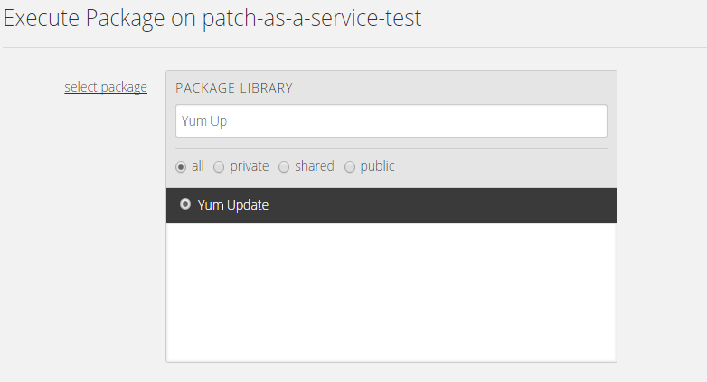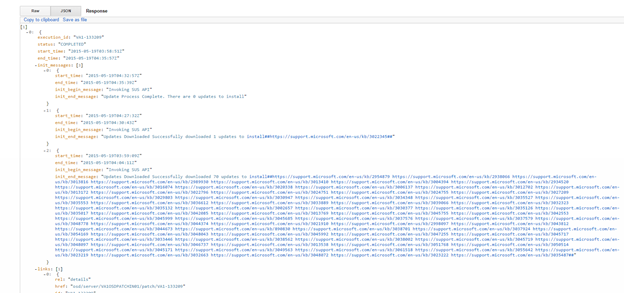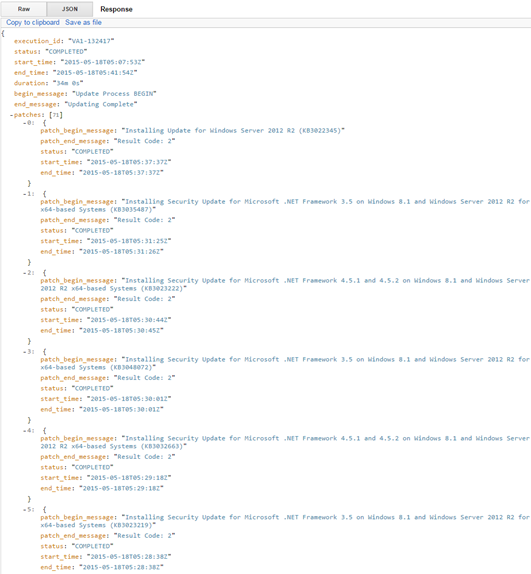{{{ "title": "Patching as-a-Service", "date": "5-29-2015", "author": "Benjamin Swoboda", "attachments": [], "contentIsHTML": false }}}
###Table of Contents
- Overview
- Audience
- Prerequisites
- Support
- Execution Options
- Option 1: Blueprint
- Option 2: Group Action
- Option 3: API
- Summary of All Patches Deployed to a Server
- Detail of Patches Deployed in an Execution
This document describes how to launch a script package for patching and how to collect information on patches deployed.
This service allows the user to patch a VM to the latest available patches provided by the OS vendor. It does not discriminate patches based on patch severity or any other vendor categorization. The package will kick off one or multiple attempts to apply patches, including a series of reboots. Reboots will cease and the execution will complete when there are no more patches to apply.
Currently, the Operating Systems that may be updated with this service are show below:
- CentOS 5
- CentOS 6
- Red Hat Enterprise Linux 6
- Red Hat Enterprise Linux 5
- Red Hat Enterprise Linux 7
- Windows 2012
- Windows 2012R2
CenturyLink Cloud Users
- A sales agreement for CenturyLink Cloud with CenturyLink (not Tier3)
- Servers with Operating Systems listed in the Overview, above
- Careful consideration of the impacts of applying all available patches to a server
- Red Hat Enterprise Linux and CentOS: This service will exclude some updates. It will exclude kernel patches and nss packages.
This service has been tested for the scope identified within this article. Product improvement is important to us so our Product Team will be aware of issues related to this service, but no one will providing direct client support. If you have suggestions for improvement, please submit a feature request.
This service is free of charge.
There are three ways to deploy the package, described below. With a Blueprint, the script package can be executed against one VM at a time. Control Portal's server group action functionality can execute against all VMs in a server group. An API request can deploy against all VMs a user is authorized to administer under a single alias.
For any method you choose, the following table will assist you with data needed for execution.
| Operating Systems | Blueprint Name | Script Package Name | Package ID |
|---|---|---|---|
| Windows 2012 and 2012R2 | Windows Update Scripts | Windows Update Scripts | 94bd395f-9b54-4693-94ae-4f3aa93fc239 |
| Red Hat Enterprise Linux 5, 6, and 7 OR CentOS 5 and 6 | Yum Update Script | Yum Update | 5d743f04-a9ce-4174-a7c8-52df93c47c08 |
Using a Blueprint, you can deploy patches against a single server through Control Portal.
1. Maintenance Mode
The process initiated by the script package may include several, automated reboots, so - regardless how you choose to execute the package - please disable alerts by putting the server(s) in maintenance mode first.
2. Select the Blueprint
Locate and select the appropriate Blueprint within the Blueprint Library. See the table above for the name of the Blueprint.
3. Click the Deploy Blueprint Button
4. Set required parameters
Select whether you want to run under the default server administrator or specify credentials. Select the server you want to patch from the drop down. Press the green “next step 2” button.
5. Review and Confirm the Blueprint
6. Deploy the Blueprint
You will see the deployment details stating the Blueprint is queued for execution. This will kick off the Blueprint deploy process and load a page where you can track the deployment progress. Deployment times may vary. Please wait for the build queue to update deployment status.
7. Deployment Complete
The execution will continue even after the completion of the script so please leave your server in maintenance mode until you receive an email informing you of completion.
8. Execution Complete
After the patching is complete you will receive an email that patching is complete. Please remove the server from maintenance mode.
Control Portal's server group action functionality allows for execution of a script package against one or multiple servers in a server group.
1. Maintenance Mode
The process initiated by the script package may include several, automated reboots, so - regardless how you choose to execute the package - please disable alerts by putting the server(s) in maintenance mode first.
2. Execute Action
Navigate to the group and select "execute package" from the action drop-down . The name of the package to search for is in the table above.
3. Deployment Complete
The execution will continue even after the completion of the script so please leave your server in maintenance mode until you receive an email informing you of completion.
4. Execution Complete
After the patching is complete you will receive an email that patching is complete. Please remove the server from maintenance mode.
An API request can deploy against all VMs a user is authorized to administer under a single alias.
1. Maintenance Mode
The process initiated by the script package may include several, automated reboots, so - regardless how you choose to execute the package - please disable alerts by putting the server(s) in maintenance mode first.
2. Execute Package
Please reference API Documentation about authentication to retrieve the Bearer token to include in all other requests. Review the Execute Package to determine how to proceed. There are currently no parameters to add. Below is a JSON example:
{
"servers": [
"{servername1}", "{servername2}"
],
"package": {
"packageId": "94644f15-a6c6-4db2-881a-bf645a56cbe0",
"parameters": {
}
}
}
3. Execution Complete
After the patching is complete you will receive an email that patching is complete. Please remove the server from maintenance mode.
A history of all executions against your server is available for your review. The response will contain a high-level overview of all the patches installed for each execution and when they were applied.
Reference API Documentation about authentication to retrieve the Bearer token to include in all other requests.
Get https://patching.useast.appfog.ctl.io/rest/servers/{alias}/server/{server}/patch
Get https://patching.useast.appfog.ctl.io/rest/servers/OSD/server/VA1OSDPATCH33/patch
| Name | Type | Description |
|---|---|---|
| accountalias | string | Short code for a particular account |
| server | string | The control-portal name assigned as VM creation, comprised of datacenter code, account alias, custom name, and two-digit number |
| Name | Type | Description |
|---|---|---|
| execution_id | string | The execution ID associated with a particular patch |
| status | string | Could be pending or completed |
| start_time | date/Time | Either the start time of the entire execution (which contains all initiations) or a particular initiation. |
| end_time | date/Time | Either the end time of the entire execution (which contains all initiations) or a particular initiation. |
| init_messages | complex | Shows the quantity of initiations |
| init_begin_message | string | "Invoking SUS API" or "Invoking yum check-update" |
| init_end_mesasge | string | identifies how many updates were installed and the URLS (for Windows) or names of the patches/updates |
Details on all attempted patches for a single execution against a server are available for your review. The response will contain information from the vendor about the patch and the status of the attempt.
Reference API Documentation about authentication to retrieve the Bearer token to include in all other requests.
Get https://patching.useast.appfog.ctl.io/rest/servers/{alias}/server/{server}/patch/{execution_id}
Get https://patching.useast.appfog.ctl.io/rest/servers/OSD/server/VA1OSDPATCH33/patch/VA1-132457
| Name | Type | Description |
|---|---|---|
| accountalias | string | Short code for a particular account |
| server | string | The control-portal name assigned as VM creation, comprised of datacenter code, account alias, custom name, and two-digit number |
| execution_id | string | Correlation ID for all the patches included with a single update execution, obtained from the Patch Summary response or emails regarding a patch request. The execution ID format will be aa#-######. |
| Name | Type | Description |
|---|---|---|
| execution_id | string | The execution ID associated with a particular patch |
| status | string | Could be pending or completed |
| start_time | date/Time | When this value is superior to patches, indicates the start time of the entire execution (which contains all initiations). When this value is inferior to patches, indicates the start time of the patch. |
| end_time | date/Time | When this value is superior to patches, indicates the end time of the entire execution (which contains all initiations). When this value is inferior to patches, indicates the end time of the patch. |
| Duration | string | The minutes and seconds between the start and end time. |
| begin_message | string | "Update Process BEGIN" |
| end_message | string | "Updating Complete" |
| patches | Number | Quantity of patches installed |
| patch_begin_message | string | Identifies the Software or OS updated and the reference number (if Windows, KB#######) for that particular update |
| patch_end_message | string | Result code established by Microsoft, defining the possible results of an install. These same codes will be used for other Operating Systems as well. https://msdn.microsoft.com/en-us/library/windows/desktop/aa387095(v=vs.85).aspx |
| status | string | for an individual patch, could be pending, completed, or failed |
